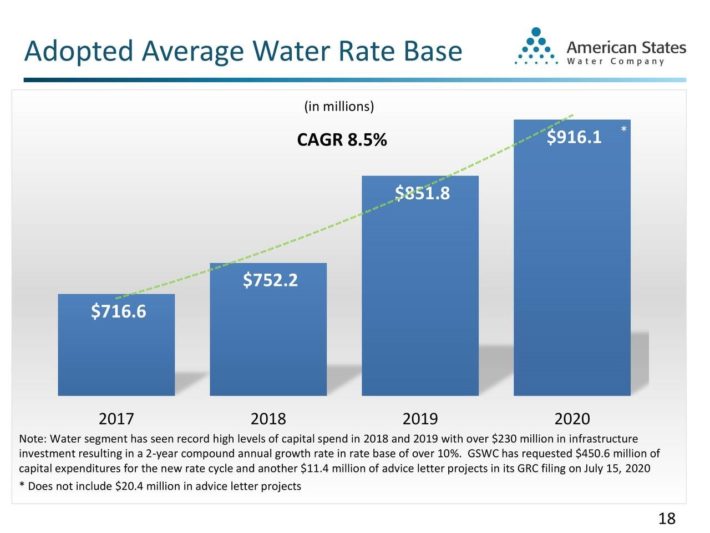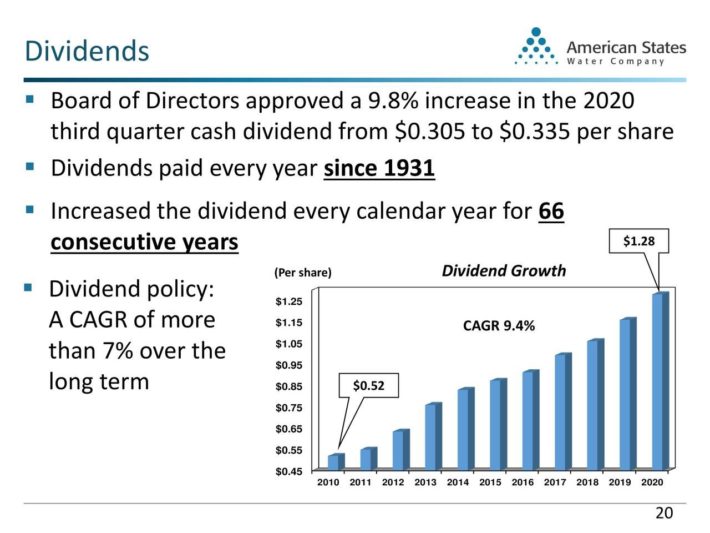Updated on October 26th, 2020 by Aristofanis Papadatos
American States Water (AWR) has an amazing track record when it comes to paying dividends to shareholders. AWR is part of the Dividend Kings, a group of stocks that have raised their payouts for at least 50 consecutive years. You can see all 30 Dividend Kings here.
We also have compiled a list of all 30 Dividend Kings. You can download the full list of Dividend Kings, plus important financial metrics such as dividend yields and price-to-earnings ratios, by clicking on the link below:
Click here to download my Dividend Kings Excel Spreadsheet now. Keep reading this article to learn more.
Dividend Kings are the best of the best when it comes to rewarding shareholders with cash and this article will discuss AWR’s dividend, as well as its valuation and outlook.
AWR has raised its dividend for 66 consecutive years and thus it has one of the longest dividend growth streaks in the investing universe. There are only three companies that have longer dividend growth streaks than AWR.
Notably, not all dividend kings are large-cap stocks. AWR has a market capitalization of only $2.8 billion but this is not necessarily a negative for investors, as it leaves ample room for future growth.
Business Overview
AWR is primarily a regulated water utility business, which serves 261,000 customers in California. It also has a regulated electric utility business in California and a non-regulated business in which it provides services for water distribution and wastewater collection in eleven military bases in the U.S.
The regulated water utility business is by far the most important division, as it generates 67% of the total revenues of the company. Due to considerable consolidation in the water utility industry in recent years, there are only 11 publicly-owned water utilities in the U.S. right now.
While the regulated water business generates most of the revenues of AWR, the non-regulated business that provides services to water and wastewater systems in military bases is significant as well. AWR has signed 50-year contracts with the military bases and thus it has secured a reliable and recurring stream of revenues.
Most utilities are slow-growth companies. They spend enormous amounts on the expansion and maintenance of their infrastructure and thus they accumulate high debt loads. As a result, they rely on the regulatory authorities to approve of rate hikes every year. These rate hikes aim to help utilities service their debt but they usually result in modest growth of revenue and earnings.
Authorities have incentive to offer attractive rate hikes to utilities in order to encourage them to continue to invest heavily in infrastructure. On the other hand, authorities try to keep consumers satisfied and hence they usually offer limited rate hikes.
AWR is a bright exception to the rule of slow growth in the utility sector. The company has grown its earnings per share at an 8.1% average annual rate. AWR has achieved a superior growth pace primarily thanks to the material rate hikes it has received from regulatory authorities and its growth in its non-regulated business. Overall, it has a less “boring” business model than a typical utility company.
In its most recent earnings report, AWR reported an 8% increase in its adjusted earnings per share, primarily thanks to rate hikes in its water utility business. While most companies have been hurt by the pandemic, AWR has not been affected at all, as the pandemic has not affected the consumer demand for water and electricity. As a result, AWR is poised to grow its earnings per share ~2% this year.
Growth Prospects
As already mentioned, utilities are slow-growth stocks in general due to the lackluster rate hikes they receive from regulatory authorities in exchange for their hefty capital expenses. AWR is superior to most utilities in this aspect, as it has enjoyed an exceptional 8.5% average annual rate hike in its regulated water business in recent years.
Source: Investor Presentation
This has helped the company grow its earnings per share at an 8.1% average annual rate over the last decade, which is one of the highest growth rates in the utility sector.
Moreover, thanks to its positive performance, its resilience to the coronavirus crisis and its bright outlook, AWR raised its dividend by 10% this year. This is one of the greatest dividend hikes in the investing universe amid the pandemic.
AWR has now grown its dividend for 66 consecutive years.
Source: Investor Presentation
It is also remarkable that management has set a goal of raising the dividend by more than 7% per year on average over the long term. This is better than the previous goal of 6% annual dividend growth the company had set. Such a high dividend growth rate is rare in the slow-growth utility sector and renders the 1.7% dividend yield of the stock somewhat more attractive.
Moreover, AWR has a markedly strong balance sheet, with an A+ credit rating, one of the highest in the utility industry. Thanks to its healthy payout ratio of 56%, its strong balance sheet and its sustained growth, AWR has good chances of delivering its ambitious goal of more than 7% annual dividend growth to its shareholders.
Going forward, AWR is likely to continue growing at a meaningful pace thanks to rate hikes in its water utility business. In addition, thanks to the highly fragmented status of the water utility business, AWR can also grow by acquiring small companies.
Another growth driver will be its military service business, as there are plenty of U.S. military bases that are eligible as prospect customers of AWR. As military bases sign 50-year contracts with AWR, they are likely to provide a growing and reliable revenue stream for AWR.
Competitive Advantages & Recession Performance
Utilities invest excessive amounts on the maintenance and expansion of their network. These amounts result in high amounts of debt but they also form impenetrable barriers to entry to potential competitors. It is essentially impossible for new competitors to enter the utility markets in which AWR operates. Even in its non-regulated business, AWR enjoys weak competition thanks to the 50-year duration of its contracts.
In addition, while most companies suffer during recessions, utilities are among the most resilient companies during such periods, as economic downturns do not affect the consumption of water and electricity.
The resilience of AWR was prominent in the Great Recession. Its earnings-per-share during the Great Recession are as follows:
- 2007 earnings-per-share of $1.56
- 2008 earnings-per-share of $1.49 (4% decrease)
- 2009 earnings-per-share of $1.61 (8% increase)
- 2010 earnings-per-share of $1.66 (3% increase)
Therefore, AWR remained resilient during the Great Recession, managing to grow its earnings per share 6% between 2007 and 2010.
The resilience of AWR is also evident in the fierce recession that has been caused by the coronavirus crisis. While most companies have incurred a material decrease in their earnings this year, AWR is on track to grow its earnings per share this year.
Overall, AWR is one of the most resilient companies during recessions and bear markets. This resilience is very important, as it supports the long-term returns of the stock and makes it easier for the shareholders to retain the stock during broad market sell-offs.
Valuation & Expected Returns
AWR is likely to generate earnings-per-share of $2.28 this year. As a result, the stock is currently trading at a price-to-earnings ratio of 33.8. This is much higher than the average price-to-earnings ratio of 24.1 of the stock in the past 10 years. We consider 25.0 to be a fair earnings multiple for this stock.
The extremely high price-to-earnings ratio can be attributed, at least in part, to the depressed interest rates, which have resulted from the pandemic. The economy has begun to recover from the pandemic but it will take years for the unemployment rate to return to its pre-COVID level. As a result, the Fed is likely to maintain record-low interest rates for a considerable period.
When interest rates are low, income-oriented investors have problem identifying attractive yields in the market and thus they view the dividend yields of utilities as more attractive. As a result, utility stock prices benefit from suppressed interest rates.
On the other hand, the market has already priced the benefit from low interest rates in the stock of AWR. Moreover, investors should pay special attention on the valuation of slow-growth stocks, such as utilities. If they overpay for a utility, it may take several years only to breakeven.
The downside risk of AWR will be significant whenever the company faces an unforeseen headwind, such as poor rate hikes or a strong economic recovery, which will result in higher interest rates. If AWR reaches our assumed fair price-to-earnings ratio of 25.0 over the next five years, it will incur a 5.9% annualized drag in its returns due to the contraction of its earnings multiple.
Moreover, AWR is currently offering a 1.7% dividend yield. We also expect the company to grow its earnings per share at a 2.7% average annual rate over the next five years. AWR may be able to grow at a faster pace but we prefer to be conservative, given the regulated nature of this business. Combined with a 5.9% annualized contraction of the price-to-earnings ratio, AWR is likely to offer a negative annual return of -1.2% over the next five years.
It appears that the market has fully appreciated the reliable earnings growth and the defensive characteristics of the stock amid the pandemic. As a result, investors should wait patiently for a much lower entry point.
Final Thoughts
AWR is much more interesting than the average utility stock, as it has some exceptional characteristics. It has grown its earnings per share at a high single-digit annual rate over the last decade. This is much better than the low growth rates of most utilities. In addition, the business of AWR includes a non-regulated segment, which provides recurring revenues for 50 years and offers significant growth potential.
AWR also provides a safe haven to investors, as it is resilient in the ongoing recession, which has been caused by the pandemic.
However, investors should realize that the market has fully appreciated all the virtues of AWR. Due to its resilience and the depressed interest rates prevailing right now, AWR is currently trading at a markedly high price-to-earnings ratio, despite its ~20% correction in the last 12 months.
As a result, the stock is likely to offer poor returns in the long run due to overvaluation. As valuation is paramount in the slow-growth utility sector, AWR receives a “sell” rating.







